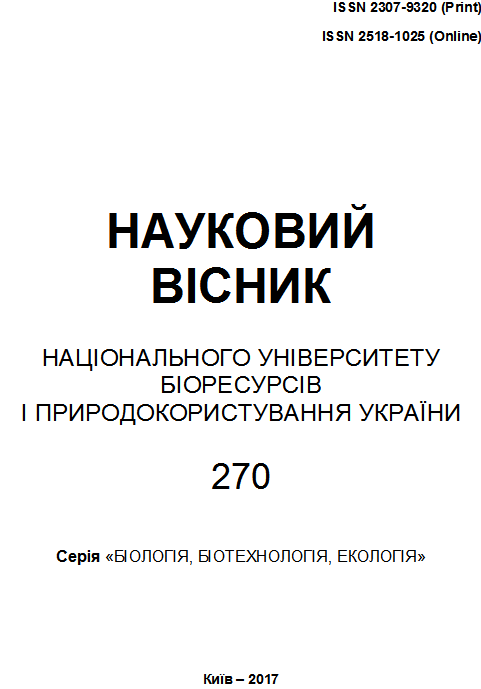FEATURES POWER SUPPLY OF TISSUES CARP CYPRINUS CARPIO L. FOR EXPOSURE TO HIGH WATER TEMPERATURE
Abstract
The peculiarities of power supply of various carp tissues under the influence of high water temperature are investigated. It was established that the processes of energy generation and energy consumption due to the unfavorable temperature factor in the tissues of the muscles, gills and liver of the mentioned species of fish are characterized by different intensity. In the muscles and gills, the content of adenine nucleotides at a temperature of 26°C is sharply reduced, whereas in the liver the change in the values of these indicators is not so pronounced. The ratio of ATP:ADP:AMP in almost all investigated tissues with a gradual increase in temperature from 24ºС to 34ºС is violated in the direction of increasing the proportion of AMP. In the case of adenylates energy charge, the results may indicate an inactivation of the ATP decomposition, as well as the inclusion of a compensatory mechanism of the carp by the body, aimed at preventing a decrease in the energy supply of tissues. The value of the main bioenergetic coefficients in the corresponding tissues at a temperature of 26°C is also reduced, but with a further rise in temperature to 34°C, the difference with the control decreases, which may indicate the development of adaptation to the adverse factor. The paper shows the dependence of the course of energy metabolism reactions, namely the exchange of adenylates, in carp tissues on the oscillatory regime of high water temperature. The obtained data indicate a different degree of energy supply of tissues of one organism under non-typical conditions.
References
Asatiani V.S. (1965). Novye metody byokhymycheskoi fotometry. Moskow, Russia. [in Russian].
Golovanov V.K. (2007). Vliyaniye skorosti nagreva na termoustoychivost karpa Cyprinus carpio v razlichnyye sezony goda / V.K. Golovanov, V.K. Smirnov // Vopr. ikhtiologii. Moskow, Russia. 47 (4). 555–561.
Nahorna N.V. (2008). Enerhetychnyi obmin klityny v normi i patolohii. Mozhlyvosti yoho otsinky / N.V. Nahorna, N.A. Chetveryk, A.A. Fedorova. Klinichna herontolohiia. 6. 58.
Orlova O.A. (2009). Vplyv parafarmatsevtyka «Vin-Vita» na stan enerhetychnoho obminu v doroslykh shchuriv / O.A. Orlova, O.O. Lazarchuk. Ukrainskyi medychnyi almanakh. 12 (5). 124–128.
Romanenko V.D., Arsan O.M. & Solomatina V.D. (1991). Mekhanizmy temperaturnoy akklimatsii ryb. Kyiv, Ukraine. [in Russian].
Skulachev V.P. (1962). Sootnosheniye okisleniya i fosforilirovaniya v dykhatelnoy tsepi. Moskow, Russia. [in Russian].
Abraham J.P. (2013). A review of global ocean temperature observations: Implications for ocean heat content estimates andclimate change / J.P. Abraham. Rev. Geophys. 51 (3).450–483.
Atkinson D.E. (1971). Adenine nucleotides as universal stoichiometric metabolic coupling agents. Advances in enzyme regulations / ed. G. Weber. New York. 207–219.
Atkinson D.E. (1977). Cellular energy metabolism and its regulation. New York: Plenum Press. 235.
Atkinson D.E. (1968). The energy charge of the adenylate pools as a regulatory arameter. Interaction with feedback modifiers / D.E. Atkinson. Biochemistry. 7 (11). 4030–4034.
Becker C.D. (1979). Evaluation of the critical thermal maximum for determining thermal tolerance of freshwater fish / C.D. Becker, R.G. Genoway. Environ. Biol. Fish. 4 (3). 245–256.
Jobling M. (1981). Temperature tolerance and the final preferendum–rapid methods for the assessment of optimum growth temperature / M. Jobling. J. Fish. Biol. 19 (4). 439–455.
Seebacher F. (2009). Responses to temperature variation: integration of thermoregulation and metabolism in vertebrates / F. Seebacher. J. Exp. Biol. 212. 2885–2891.
Downloads
Published
Issue
Section
License
Relationship between right holders and users shall be governed by the terms of the license Creative Commons Attribution – non-commercial – Distribution On Same Conditions 4.0 international (CC BY-NC-SA 4.0):https://creativecommons.org/licenses/by-nc-sa/4.0/deed.uk
Authors who publish with this journal agree to the following terms:
- Authors retain copyright and grant the journal right of first publication with the work simultaneously licensed under a Creative Commons Attribution License that allows others to share the work with an acknowledgement of the work's authorship and initial publication in this journal.
- Authors are able to enter into separate, additional contractual arrangements for the non-exclusive distribution of the journal's published version of the work (e.g., post it to an institutional repository or publish it in a book), with an acknowledgement of its initial publication in this journal.
- Authors are permitted and encouraged to post their work online (e.g., in institutional repositories or on their website) prior to and during the submission process, as it can lead to productive exchanges, as well as earlier and greater citation of published work (See The Effect of Open Access).

